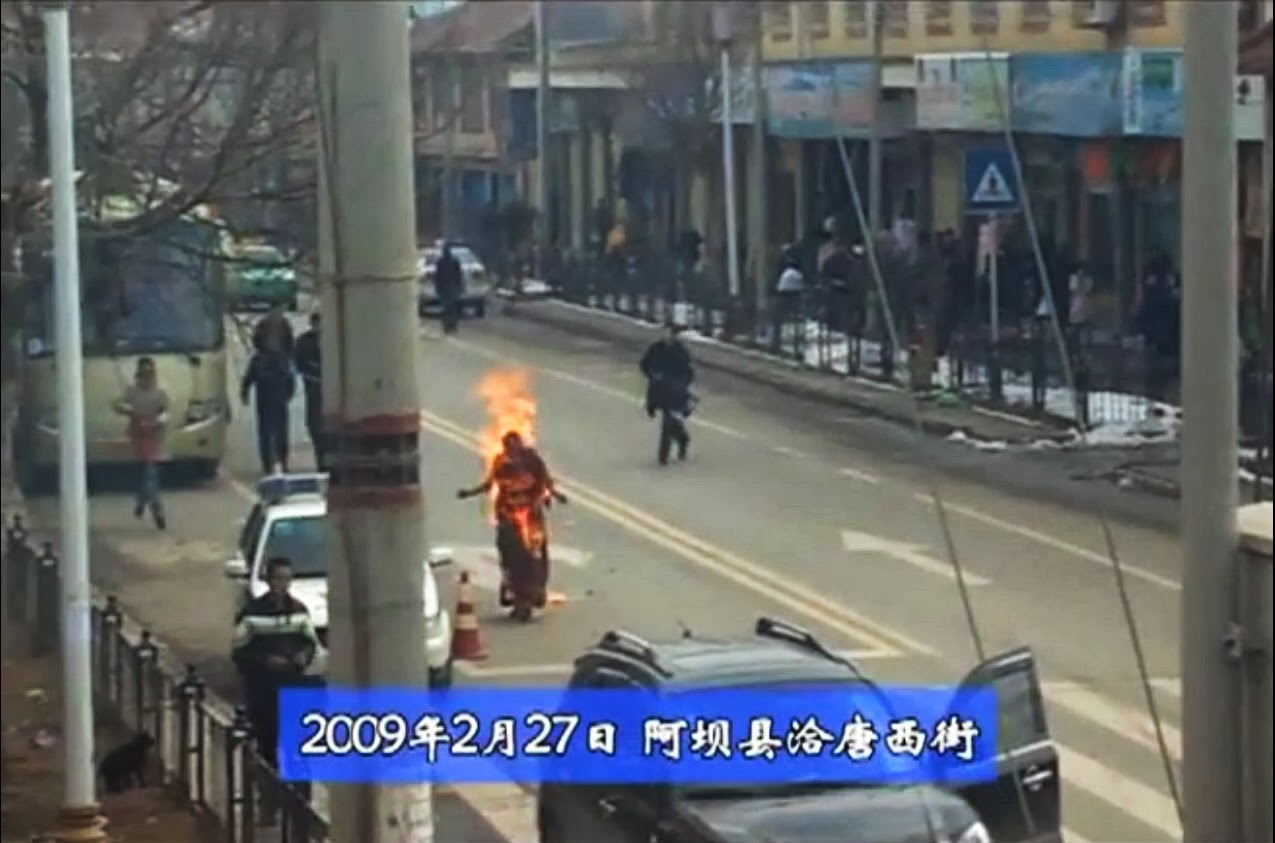High Peaks Pure Earth has translated a blogpost by Woeser written in December 2013 for the Mandarin service of Radio Free Asia and published on her blog on December 27, 2013.
In this post, Woeser returns to the subject of the ongoing self-immolations in Tibet, incidents that Woeser has been meticulously documenting on her blog. Woeser also writes about Lhasa as the destination for Tibetan pilgrims from all over Tibet and the surveillance they are under – bearing in mind how hard it has been in recent years for Tibetans outside the Tibet Autonomous Region to enter at all.
Woeser points out that most of the pilgrims coming to Lhasa are from the areas in Amdo and Kham where the self-immolations are taking place. The only self-immolations to take place in Lhasa were carried out by two Tibetans from Amdo on May 27, 2012. For a list of self-immolations maintained by International Campaign for Tibet, follow this link.
The photos above show 6 self-immolations scenes
out of the 129 Tibetans who have self-immolated since 2009.
“Tibetans Walking Out of the Flames Towards Lhasa”
By Woeser
On December 3, 2013, in Ngaba, Amdo (today’s Ngaba county, Ngaba Tibetan and Qiang Autonomous Region, Sichuan Province), the 30-year-old herdsman Kunchok Tseten self-immolated in front of Meu Ruma township government; he passed away while he was taken by military police to the prefecture government of Barkam county. On December 19, 2013, in Sangchu (today’s Sangchu county, Kahlho Tibetan autonomous prefecture, Gansu Province), the 42-year-old monk Tsultrim Gyatso self-immolated in Amchok and passed away on the spot.
The self-immolations of these two Tibetans made the total number of self-immolations since 2009 rise to 129 (124 inside and 5 outside of Tibet). Between January and December 2013, 28 self-immolations occurred (26 inside and 2 outside Tibet). At present, we know that 110 have passed away, 107 inside and 3 outside Tibet. These are shocking numbers because they reflect the loss of actual human lives.
I remember in November last year, when I was about to leave Lhasa, no matter whether going to a monastery or whether going to the Barkhor to spin prayer wheels, I always met a lot of Tibetans coming from Amdo and Kham, men and women, young and old. After months of being disallowed to enter Lhasa, they could finally make a pilgrimage to the city. Even though when entering Lhasa they were interrogated, had to exchange their ID cards for a temporary permit only valid for their time in Lhasa, could only stay in specially assigned hotels and were often searched or questioned in public spaces, they finally had the chance to see Jowo Rinpoche enshrined inside Jokhang Temple, they could finally pray facing the Potala Palace, they could finally walk along every single prayer path and prostrate.
I would always stop them and ask them where they were from and they would always tell me that they came from the places where Tibetans self-immolated and most of them were of the same age as those that self-immolated. Meeting them was like meeting the relatives of self-immolators. On Twitter the artist Ai Weiwei and I discussed these Tibetans coming from far away; Ai Weiwei once sighed: “These Tibetans who walked out of the flames, where are they going? Where can they find comfort? …I don’t even know if they can be comforted at all…” Originally, Lhasa would have been a place of comfort for them, but it is painful to see the streets of the city being filled with inspection points, police service points, seeing these Tibetans being searched, their mobile phones and temporary residence permits being checked; it is painful that they have no alternative but to accept this “straitjacket”.

Not so long ago, the Lhasa security bureau issued a notice to all hotels, specifying:
“…Registration process for people required to report to the authorities: inspect and verify the guest’s ID – report to the authorities – verification by Public Security Bureau – registration – check into hotel – check out of hotel – register time of departure – register the check out time of all guests required to report to the authorities (people from within Tibet: Kham, three eastern counties in Nagchu Prefecture, Biru county, Sog county, Baqen county; people from outside TAR: Qinghai, Gansu, Yunnan, Sichuan, Xinjiang (except for Chinese)). People from the five Tibetan provinces and Xinjiang (except for Chinese) who come to Lhasa on pilgrimage, visit relatives, treat an illness, travel, engage in business etc, have to have their IDs checked and need to report to the local police bureau within 10 minutes after registration (telephone number: 6823809); the local police bureau needs to also within 10 minutes verify whether the person can check in. In case of any violations such as failing to report, registering more than one person under one ID, not having registered according to the regulations, having checked into a hotel without registration, registering under a different name, holding an expired ID card etc. people will be severely punished in accordance with the respective laws and regulations, which will have serious consequences and the hotel may be closed down.”
 I heard that when the Lhasa security bureau gathered all hotel managers for a meeting they used the case of two young Tibetans from Amdo self-immolating on May 27, 2012, on the prayer-wheel path between the Jokhang Temple and Barkhor police station as an example, warning all hotels to pay particular attention and report any non-local Tibetans checking in. If someone self-immolates, the security bureau said fiercely: “Then you will become the next ‘Mandala Hotel’, which will ruin your family and leave you destitute and homeless.” This sentence started spreading around Lhasa under the pseudonym of “eight words” (referring to the two 4-letter-words in Chinese that were used to convey the message).
I heard that when the Lhasa security bureau gathered all hotel managers for a meeting they used the case of two young Tibetans from Amdo self-immolating on May 27, 2012, on the prayer-wheel path between the Jokhang Temple and Barkhor police station as an example, warning all hotels to pay particular attention and report any non-local Tibetans checking in. If someone self-immolates, the security bureau said fiercely: “Then you will become the next ‘Mandala Hotel’, which will ruin your family and leave you destitute and homeless.” This sentence started spreading around Lhasa under the pseudonym of “eight words” (referring to the two 4-letter-words in Chinese that were used to convey the message).
“Mandala Hotel”, once situated opposite the southern side of Jokhang Temple, was the place where the two young Tibetans from Amdo stayed before they self-immolated. The local authorities took their anger out on this hotel, arresting the couple who was running it and also the doorman; they also confiscated the entire property of the hotel and changed it into the “Lhasa City Barkhor Old Town Management Committee”, and with this the local police station was hurriedly upgraded to “Barkhor Old Town Public Security Bureau”. The old town of Lhasa was then renamed into “Barkhor Old Town”, using this as an opportunity to initiate various large-scale old town redevelopment projects. Yet, the goal and plan really was “the maintenance of stability”, so one can say it was really killing two birds with one stone.
December 2013
The photos below were taken by me while I was in Lhasa between September and November 2013. They show Jokhang Temple square, Sera monastery and the Barkhor. The Tibetans in these photos all came from Amdo and Kham on pilgrimage, they were all strangers. They are wearing the yellow or white khatas given to them by the monks of the Jokhang Temple or Sera monastery. This means that they have contributed gold that will be added to the sacred Buddha statues in the monasteries.


















I hope you are in good health Woeser la. Please take care, you are one of my heros.